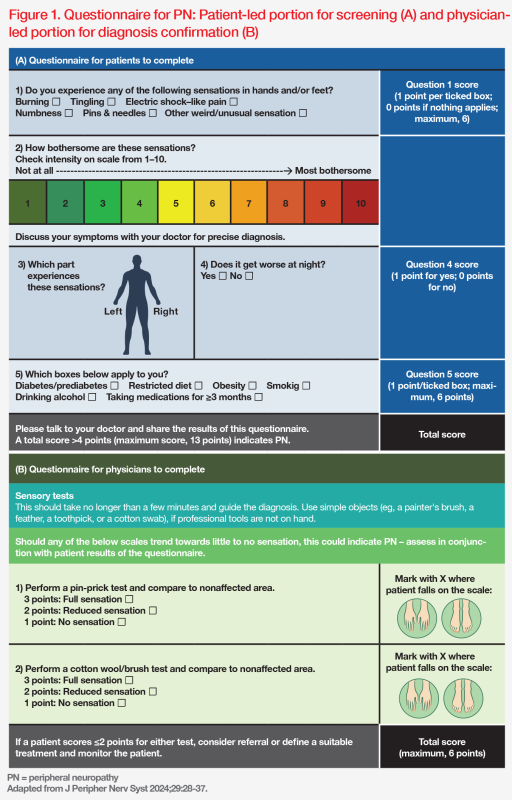
Early recognition of peripheral neuropathy (PN) is crucial to prevent or delay disease progression and development of associated complications. In an interview with MIMS Doctor, Dr Vivien Lim, Specialist in Endocrinology at the Gleneagles Medical Centre in Singapore, discussed potential reasons for delayed PN diagnosis, particularly in patients with diabetes mellitus (DM). She also introduced a simple questionnaire developed by a panel of neurologists and endocrinologists for both patients and physicians, to urge early detection of PN in the primary care setting.
Gaps in PN detection
PN, a neurological condition of variable aetiology, is characterized by numbness, pain or burning sensation in the feet, which can impact patients’ mobility and daily activities. PN’s reported prevalence is up to 8 percent in the general population, which, however, is likely an underestimate, as latest epidemiology data showed that up to 80 percent of patients with PN may remain undiagnosed. [J Peripher Nerv Syst 2024;29:28-37; JAAPA 2020;33:9-15]
“In particular, diabetic PN [DPN], which is one of the most common types of PN, is reported to be undiagnosed in 88 percent of patients in Hong Kong and Taiwan, and in up to 99.8 percent of patients in Malaysia,” shared Lim. [Diabetes Educ 2011;37:536- 548; Adv Ther 2017;34:1426-1437; J Peripher Nerv Syst 2024;29:28-37]
“Early screening for PN is important for detecting subclinical disease and optimizing management before progression,” she noted. “However, PN diagnosis is often delayed, and patients may experience symptoms for ≥5 years before receiving diagnosis.” [Semin Neurol 2019;39:519-530; J Peripher Nerv Syst 2024;29:28-37]
Delayed diagnosis of PN may be due to several factors involving both patients and physicians. “Patients’ lack of disease awareness may lead to delayed reporting of symptoms until their daily lives are substantially affected,” said Lim. “Meanwhile, physicians may not proactively screen for PN, as they typically prioritize other potential disease complications [eg, microvascular and macrovascular complications of DM] associated with increased morbidity and mortality risks. Furthermore, in primary care, validated diagnostic tools may not be readily available or may be too complicated to use routinely, while other tools such as the 10-g monofilament test for DPN may only detect advanced neuropathy.” [J Peripher Nerv Syst 2024;29:28-37]
A simplified questionnaire for PN detection
“After an expert meeting with neurologists and endocrinologists from the Middle East, Southeast Asia and Latin America, we reached a consensus on the need to improve PN detection, specifically in the primary care setting,” said Lim. [J Peripher Nerv Syst 2024;29:28-37]
“We developed a simplified questionnaire-based tool for PN screening that has two parts – one part is self-administered by patients, and the other part is used by physicians,” she explained. “By engaging patients in the screening process, we aim to shift the focus of control to the individual. The questionnaire provides a simple, self-administered screening tool for presumptive risk assessment based on symptoms of PN, which in turn will alert physicians to perform a neurological examination, conduct further investigations, and, if appropriate, refer to secondary care to diagnose PN and its aetiology.” (Figure 1)
“When we developed the self-administered questionnaire for patients, weconsidered the time and their level of literacyrequired to complete it. Moreover, we tookinto consideration that physicians wouldfind a short, simple and accurate tool for PNscreening more useful,” said Lim. “Thus, ourquestionnaire aims to both empower thepatient in the screening process and makeit easy for the physician in a busy clinic touse, and to reduce their time for makinga diagnosis of PN.” [J Peripher Nerv Syst 2024;29:28-37]

Answering the questionnaire
The five-item patient-led part of the questionnaire serves as an initial screening tool for PN and helps raise awareness about the possibility of having PN. (Figure 1A) [J Peripher Nerv Syst 2024;29:28-37]
The first two questions target typical symptoms of PN in the feet and hands, and their severity. “By simply answering these two questions, patients are encouraged to discuss any relevant sensory issues with a doctor. Furthermore, PN awareness can be raised among individuals who are not experiencing any related symptoms,” Lim said. (Figure 1A)
The remaining questions serve as further indicators for PN diagnosis. For instance, worsening symptoms at night help differentiate PN from morning mechanical pain, while the last question outlines major risk factors of PN, increasing patients’ awareness about potential aetiologies of the disease. (Figure 1A)
“The simple and versatile patient-led questionnaire incorporates a scoring system with different levels of comprehensiveness. Patients can stop after the first two questions or complete the entire questionnaire based on their individual needs, with minimal assistance across various settings, including physicians’ clinic and the pharmacy,” noted Lim.
The physician section comprises only a two-item assessment of sensation to pinprick and a cotton wool/brush test on precise locations on the hand and foot. If patients score ≤2 points for either sensory test, further management or referral should be considered. (Figure 1B) “The assessment tools needed for the sensory tests are easily accessible,” remarked Lim.
Summary and future outlook
“Early identification of PN is important. We should not wait for patients to complain [about the symptoms before taking action],” shared Lim. “Our simplified questionnaire for both patients and physicians may help early PN diagnosis, and will hopefully be amenable for routine daily use, especially in the primary care setting.”
Further validation of the patient-doctor questionnaire vs established PN diagnostic tools is aimed to be initiated this year.